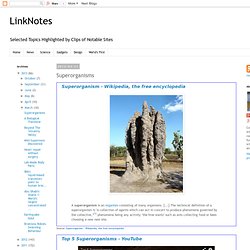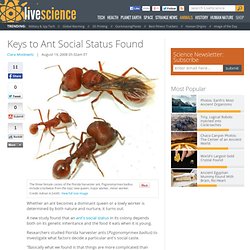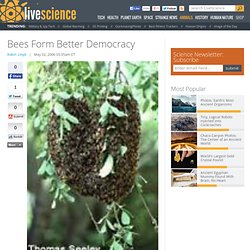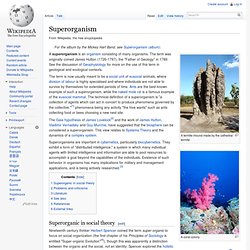

Superorganisms. Superorganism - Wikipedia, the free encyclopedia.

Robots Mimic Ant Colony Behavior. Robot swarms can mimic how ant colonies navigate complex mazes relatively mindlessly, researchers have found ― knowledge that could help to improve designs for manmade transportation networks.

Scientists are fascinated by ant colonies because they can form collectives called "superorganisms" that function as single organisms do. Investigation into how ants behave has revealed more about how such group behavior arises, and some researchers are using that knowledge to help build smarter robot swarms, said Simon Garnier, a scientist who studies animal behavior at the New Jersey Institute of Technology.
Scientists are making ants wander through mazes, just as they do with rats. These labyrinths mimic the twists and turns in ants' journeys between their nests and places rich in food. Ants that reach a fork in a road usually follow the branch that diverges the least from the direction in which they came, recent studies have shown. [Robotic Insects Take Flight on Printed Wings] Top 5 Superorganisms. Insect Colonies Function Like Superorganisms. Insect colonies, although composed of many critters, function in a manner similar to individual organisms, according to a new study.

The results suggest that these colonies act like "superorganisms," at least in terms of their basic physiology. Many insect species, including ants and bees, work together in colonies, and their cooperative behavior determines the survival of the entire group. This type of interaction has been likened to that of a single organism, with each individual in a colony acting like a cell in the body, giving rise to the term "superorganism. " However, although this phrase has been around for at least a century, it has generally been used as a metaphor, and very few, if any, studies have quantitatively compared whole colonies to individual organisms, said study researcher James Gillooly of the University of Florida.
So this study marks the first for a quantitative assessment of the link between social colonies and a single organism, Gillooly said. The moving parts. Keys to Ant Social Status Found. Whether an ant becomes a dominant queen or a lowly worker is determined by both nature and nurture, it turns out.

A new study found that an ant's social status in its colony depends both on its genetic inheritance and the food it eats when it is young. Researchers studied Florida harvester ants (Pogonomyrmex badius) to investigate what factors decide a particular ant's social caste. "Basically what we found is that things are more complicated than previously thought," said researcher Christopher R. Bees Form Better Democracy. Take it from bees.

Intense competition is better than touchy-feely "win-win" negotiations when it comes to making big decisions. Ten years of painstaking research on how swarms of honeybees choose a new hive now shows their voting process for selecting new real estate is efficient and yields some losers while avoiding the folly of the collective, or of trying to come to a consensus. The bees' approach might sound hardcore and less than democratic.
But it almost always results in the choice of the best home among available options, said Thomas Seeley of Cornell University. Rich Streams of Bacterial Life Found on Skin. Human skin hosts a huge, diverse population of bacteria that changes based on local skin conditions such as dry, moist and oily.

Such findings come out of the Human Microbiome Project, which involves researchers working to genetically identify the vast swarm of microbes living in and on the human body. Part of the project focuses on the human skin. The latest study discovered a wide array of bacteria at 20 separate skin sites, depending on the local skin's "ecosystem," said Julia Segre, a molecular biologist at the National Human Genome Research Institute and senior author on the research detailed in the May 29 issue of the journal Science.
"We use the analogy that the skin is like a desert with large dry areas, but then there are these streams, or creases of your body," Segre said. "There's much richer bacterial life in the streams. " Disturbances in the bacterial balance can lead to foreign species moving in and possibly contributing to human diseases. Superorganism. A termite mound made by the cathedral termite A coral colony A superorganism is an organism consisting of many organisms.

The term was originally coined James Hutton (1726-1797), the "Father of Geology" in 1789. See the discussion of Geophysiology for more on the use of this term in geological and ecological contexts. The term is now usually meant to be a social unit of eusocial animals, where division of labour is highly specialised and where individuals are not able to survive by themselves for extended periods of time. The Gaia hypothesis of James Lovelock[2] and the work of James Hutton, Vladimir Vernadsky and Guy Murchie, have suggested that the biosphere can be considered a superorganism. An Evolutionary Explanation for Altruism. In a red-in-tooth-and-claw natural world, where self-interest seems to be a form of fitness, how does altruistic behavior arise?

It’s a fascinating question, and one that has been particularly engaging to entomologists who study compex insect societies that are conceptualized as "superorganisms" — singular entities formed by the interactions of their constituent members — rather than as thousands of separate bugs. (Okay, okay, "red-in-proboscis-and-antenna. " It just doesn’t sound as good.) The latest explanation comes from Cornell University neurobiologist Ken Reeve and Bert Hölldobler of Arizona State University’s Center for Social Dynamics and Complexity. As an insect society becomes more organized and labor is divided, they theorize, individual tendencies towards inclusive fitness — i.e., altruism that increases the chance of perpetuating genes held in common with other individuals — are maximized.
I sent Dr. A Brief History of the Superorganism, Part Two. At first glance, superorganism theory confounds the way we’re trained to think of evolution as acting purely on individuals, driven by so-called selfish genes.

This isn’t wrong, but it’s not complete. Genes that code for beneficial traits are favored, but genes come in big groups with lots of other genes. These are contained by individuals. Individuals who are best-suited for survival are favored, along with the whole motley collection of their genes — but these individuals exist in populations, and whole populations, which have properties determined by the interaction of their individuals, are also selected for. In essence, evolution operates at many different levels, and at the highest level are whole populations.
Evolutionary biologist and superorganism pioneer Bert Hoelldobler talked to me about the history of superorganism theory. Leafcutter ants make unbelievable nest structures. It’s as exciting as understanding the pattern of a brain. Learn more about superorganisms.